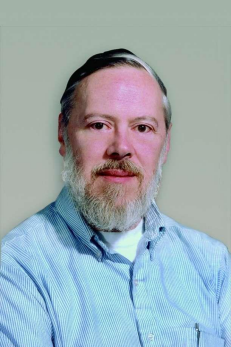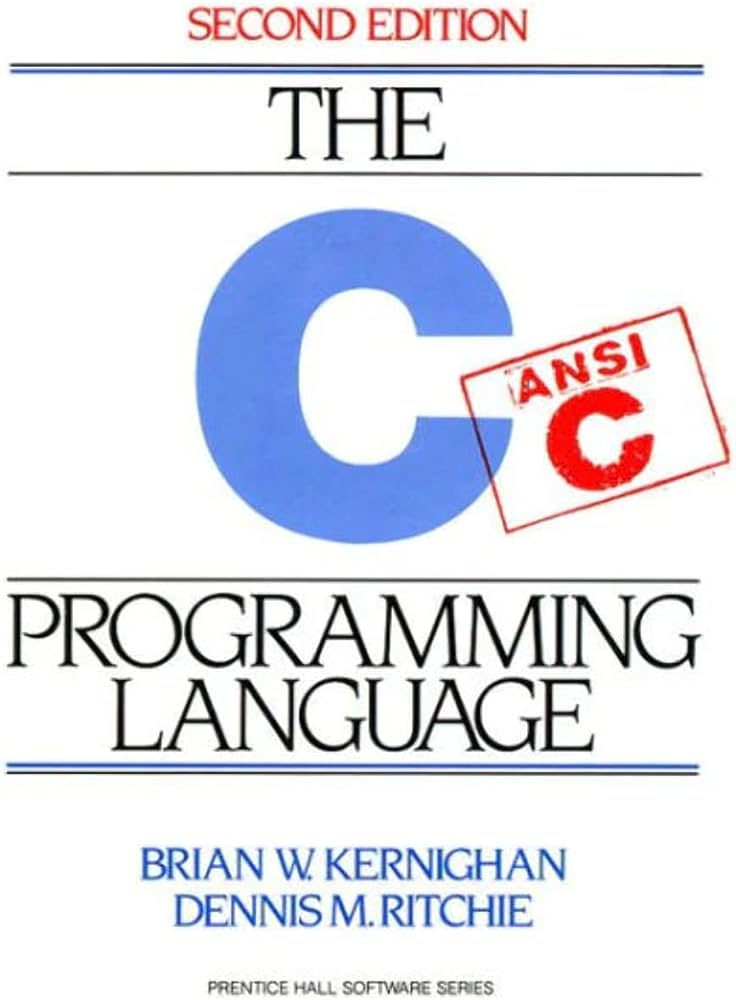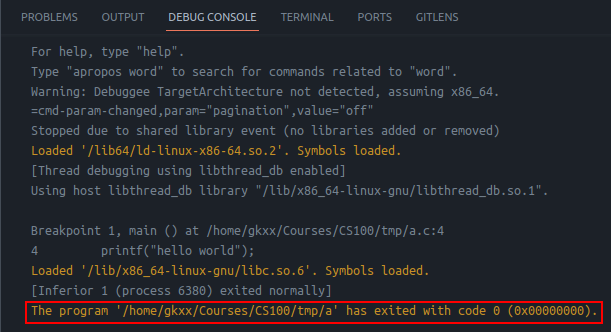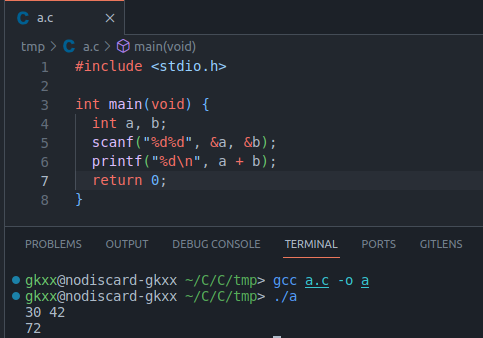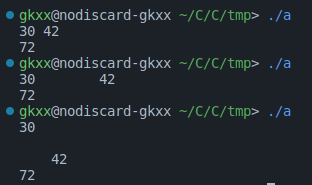CS100 Lecture 1
The First C Program
Contents
- Brief history of C
- The first C program
- Functions (basic) and the
mainfunction scanfandprintf
Brief history of C
The UNIX operating system and C
- In 1969, a small group of AT&T Bell Labs led by Ken Thompson and Dennis Ritchie began to develop UNIX.
- In 1973, UNIX kernel was rewritten in C.
- From 1969 to 1973, Dennis Ritchie developed C in Bell Labs.
- In 1978, Kernighan and Ritchie published the K&R book: The C Programming Language.
Dennis Ritchie and the K&R book
Standardization of C
- "K&R C": Informal specification (the K&R book)
- ANSI C: Known as "C89"
- American National Standards Institute
- Came out in 1989
- ISO C standard: ISO/IEC 9899
- International Organization for Standardization
- First version: "C90" in 1990, the same standard as C89 with only formatting changes
- C99 (1999), C11 (2011), C17 (2017/2018), C23 (2023)
The first C program
Hello World
#include <stdio.h>
int main(void) {
printf("hello world\n");
return 0;
}
- Save the code as
hello.c. gcc hello.c -o hello.exe\(\Rightarrow\) generateshello.exe.\hello.exe\(\Rightarrow\) printshello world, with a newline at the end.
The main function
Every C program coded to run in a hosted execution environment contains the definition of a function named main, which is the designated start of the program.
// Other things (functions, structures, ...), if any ...
int main(void) {
// The program starts here.
statement_1;
statement_2;
// ...
statement_n;
}
* What is a function?
A function in C
A function in mathematics: \(f:S\mapsto T\), accepts some arguments and returns some value.
Example: \(f(x)=x^2,x\in\mathbb Z\) accepts an integer argument, and returns its square.
Write it in C:
int f(int x) {
return x * x;
}
A function in C
Example: \(f(x, y)=x+y,x,y\in\mathbb R\)
Write it in C:
double f(double x, double y) { // Two arguments
return x + y;
}
double: double-precision floating-point number \(\Rightarrow\) will be covered in later lectures.
A function in C
Syntax: ReturnType FunctionName(Parameters) { FunctionBody }
FunctionBody can also contain more complex statements:
int max(int a, int b) {
if (a < b)
return b;
else
return a;
}
if statement \(\Rightarrow\) will be covered in later lectures.
A function in C
Syntax: ReturnType FunctionName(Parameters) { FunctionBody }
A function can have no arguments. To define such a function, write void in Parameters:
int always42(void) {
return 42;
}
We will introduce more on functions in later lectures.
The main function
Every C program coded to run in a hosted execution environment contains the definition of a function named main, which is the designated start of the program.
According to the standard, the main function must has one of the following signatures:
int main(void) { ... }int main(int argc, char *argv[]) { ... }/* another implementation-defined signature */
For now, we only use the first one: int main(void) { ... }.
"signature": consisting of the return-type, parameters, and some other possible information
The main function
int main(void) {
printf("hello world\n");
return 0;
}
The return value of main: Indicates whether the program exits successfully.
A program exits successfully if and only if its main function returns 0.
The main function
A program exits successfully if and only if its main function returns 0.
You may also see this somewhere else:
The main function
A program exits successfully if and only if its main function returns 0.
You may also see this somewhere else:
The main function
It is ok to omit return 0; in main (but not in other functions):
int main(void) {
printf("hello world\n");
}
According to the standard:
If the return type is compatible with
intand control reaches the terminating}, the value returned to the environment is the same as if executingreturn 0;.
printf
Declared in the standard library header file stdio.h.
- That's why we need
#include <stdio.h>in the beginning.
Writes something to the standard output.
printf("hello world\n");
- Prints
hello world, with a newline\nat the end. - Try this out:
printf("hello\nworld\n");
Output vs return
int main(void) {
printf("hello world\n");
return 0;
}
- What is the output of the program?
- What is the return value of
main?
Output vs return
int main(void) {
printf("hello world\n");
return 0;
}
- What is the output of the program? \(\Rightarrow\)
hello worldwith an ending newline. - What is the return value of
main? \(\Rightarrow\)0.
The "A+B" problem
Reads two integers from input (separated by whitespaces), and prints the sum of them.
#include <stdio.h>
int main(void) {
int a, b; // declares two variables of type "int", named "a" and "b".
scanf("%d%d", &a, &b);
printf("%d\n", a + b);
return 0;
}
The "A+B" problem
Reads two integers from input (separated by whitespaces), and prints the sum of them.
scanf
Also declared in stdio.h.
Reads something from the standard input.
Example: Reads two integers from the standard input, separated by whitespaces.
scanf("%d%d", &a, &b);
%d: Indicates that an integer is expected, and will be stored into anintvariable.&: The address-of operator \(\Rightarrow\) will be covered in later lectures.
For now, just remember to add & when passing things to scanf.
scanf
scanf("%d%d", &a, &b);
How should these two integers be separated? Try it out:
scanf
scanf("%d%d", &a, &b);
%d will skip any leading whitespaces.
- "whitespace" refers to the character that looks "blank": space
' ', newline'\n, tab'\t', etc.
More on the rules related to scanf will be covered in recitations.
printf printing an integer
Given a \(=30\), b \(=42\) as input:
printf("%d\n", a + b);
\(\Rightarrow\) prints 72, with a newline in the end.
printf("%d + %d equals %d\n", a, b, a + b);
What is the output?
printf printing an integer
Given a \(=30\), b \(=42\) as input:
printf("%d\n", a + b);
\(\Rightarrow\) prints 72, with a newline in the end.
printf("%d + %d equals %d\n", a, b, a + b);
\(\Rightarrow\) prints 30 + 42 equals 72, with a newline in the end.
Summary
Understand the following two programs:
#include <stdio.h>
int main(void) {
printf("hello world\n");
return 0;
}
#include <stdio.h>
int main(void) {
int a, b;
scanf("%d%d", &a, &b);
printf("%d + %d equals %d\n",
a, b, a + b);
return 0;
}
Summary
- Why is
#include <stdio.h>needed? scanfandprintfare declared in the standard library header filestdio.h.- What does
int main(void)mean? - The
mainfunction is where the program starts.intis the return type andvoidindicates that this function accepts no arguments. - What is the meaning of
return 0;? Can it be omitted? - A program returns
0if it exits successfully. Themainfunction of C will executereturn 0automatically at the end if we don't write it exiplicitly.
Summary
- How do we represent a newline?
'\n'.- What does
%dmean? - Indicates that the type of the data being read or printed is
int. - How are whitespaces handled when reading integers with
scanf? - When reading
intwith%dinscanf, leading whitespaces are ignored.
Exercises
- Run the following code. Try to understand what it means.
```c
#include
int max(int a, int b) { if (a < b) return b; else return a; }
int main(void) { int a, b; scanf("%d%d", &a, &b); printf("%d\n", max(a, b)); return 0; } ```
Exercises
- Try to modify the program above. Add some prompts for input and output. For example:
